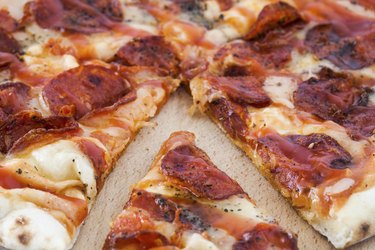
Between 2007 and 2010, the U.S. Department of Agriculture reported that one in eight people consumed pizza on any particular day. A takeout pizza makes a convenient meal during a hectic day, but people with diabetes should consider carbohydrates, sodium, saturated fat and portion size before speed-dialing their favorite pizza parlor.
The Diabetic Diet
Video of the Day
Pizza contains carbohydrates, nutrients that provide energy and influence your blood sugar levels. For optimal blood sugar control, the American Diabetes Association recommends limiting your carbohydrate intake to 45 to 60 grams per meal. Diabetes puts extra strain on the cardiovascular system, raising heart disease risk. Cheese and high-fat pizza toppings, such as pepperoni, bacon, ham and sausage, contain high levels of saturated fat and sodium, which need to be limited on a heart-healthy diet. The American Diabetes Association recommends a maximum intake of 2,300 milligrams of sodium a day, or 1,500 milligrams if you have hypertension. Saturated fat should make up no more than 10 percent of your daily calories.
Video of the Day
Nutrition Facts of Pizza
One slice of cheese pizza from a fast-food restaurant contains 285 calories, 5 grams of saturated fat and 36 grams of carbohydrates. This represents 60 percent to 80 percent of the recommended carbohydrates for an entire meal. One slice also provides 640 milligrams of sodium, 28 percent of the daily recommended maximum. Adding pepperoni to your pizza increases your slice to 339 calories, 6 grams of saturated fat, 37 grams of carbohydrates and 807 milligrams of sodium. The nutrition facts of takeout pizza vary widely, so look for nutrition information at your favorite pizza place before ordering.
Cutting Carbohydrate Intake
A slice of plain cheese pizza on a regular crust has a glycemic index rating of 80, making it a high-glycemic food. High-glycemic foods raise blood sugar quickly, so people with diabetes should limit these foods in their diet. Pizza dough usually contains all-purpose flour, a processed, low-fiber grain. Fiber reduces the glycemic index of foods, so choose a high-fiber, whole-grain crust for your pizza. If a whole-grain option is not available, order a thin crust instead of a thick crust. Fresh vegetable toppings also provide fiber and contain virtually no fat and sodium. Processed tomato sauce is a high-glycemic food, so ask for minimal sauce or order fresh tomatoes on your pizza instead.
Tips for Meal Planning
Because one slice of takeout pizza contains most of your carbohydrate intake for one meal and lots of saturated fat and sodium, avoid other less nutritious side dishes at your pizza place. Fried chicken wings contain 7 grams of carbohydrates and 4 grams of saturated fat per wing. Colorado State University reports that one bread stick provides 100 to 140 calories, and most varieties are made with refined flour. If you want a side dish with your pizza slice, order a side salad with low-fat dressing or roasted mixed vegetables. Skip the soda or sweetened beverages and enjoy water or unsweetened iced tea with your pizza.
- American Diabetes Association: About Our Meal Plans
- American Diabetes Association: Diabetes and Heart Health - What's the Connection?
- USDA National Nutrient Database: Fast Food, Pizza Chain, 14" pizza, Cheese Topping, Regular Crust
- USDA National Nutrient Database: Fast Food, Pizza Chain, 14" Pizza, Pepperoni Topping, Thick Crust
- American Diabetes Association: Glycemic Index and Diabetes
- Oregon State Extension: Glycemic Index and Glycemic Load for 100+ Foods
- USDA National Nutrient Database: Fast Foods, Fried Chicken, Wing, Meat and Skin and Breading
- Colorado State University: Nutrition Column - What Does Pizza Deliver?
- U.S. Department of Agriculture: Consumption of Pizza
- Malcalster College Athletics: Glycemic Index for Athletes